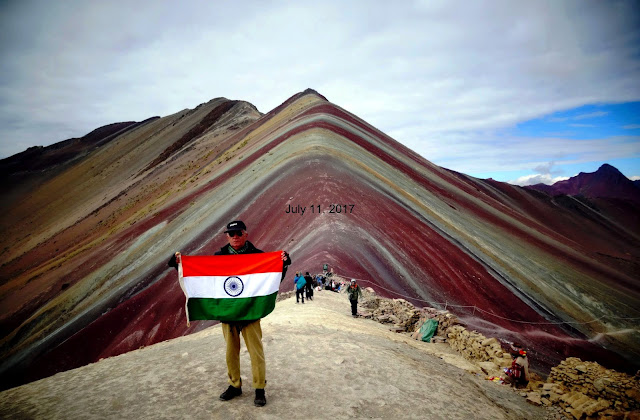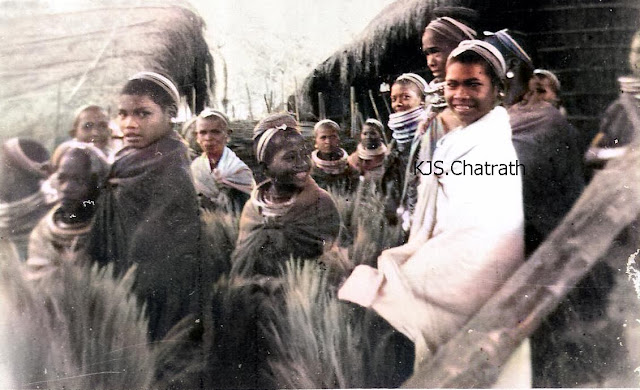'Remembering ascent to the Rainbow Mountain top (16,500 ft), Peru, 5 years back' - by K J S Chatrath
I, along with my batch mate in the IAS and tough trekker Gopal Ganesh,
climbed up the Rainbow Mountain in Peru in July 2017. Till 2015, one of
the most fascinating wonders of this planet, the Rainbow Mountain was
practically unknown, except to a small number of indigenous Peruvians
living around it. Then the information appeared on the social media and
soon travel enthusiasts around the world were talking about it. Now it
has become a preferred destination for adventure lovers.
The
mountain has stripes of colours of the rainbow and hence the name.
These colours are natural geographical formations and are due to
prolonged impact of weather conditions and mineralogy. Red colour
indicates presence of iron oxide, rust and brownish colour are said to
indicate goethite or oxidized These coloured strips are called
stratigraphic formations or defined layers.
Ausangate
or Auzangate, as this mountain is called, is a part of the Vilcanota
mountain range in the Peruvian Andes. It is situated around 100
kilometres southeast of Cusco, at an elevation of 6,384 metres or around
20,000 feet. This region is inhabited by llama and alpaca herding and
pastoral communities.
This mountain is considered holy in Incan mythology as the deity of Cusco by local Peruvians. It is a site of daily worship and offerings by local inhabitants. Every year thousands of Quechua pilgrims visit the Ausangate Mountain for the Star Snow festival Quyllur Rit’i which takes place a week before the Corpus Christi festival.
This mountain is considered holy in Incan mythology as the deity of Cusco by local Peruvians. It is a site of daily worship and offerings by local inhabitants. Every year thousands of Quechua pilgrims visit the Ausangate Mountain for the Star Snow festival Quyllur Rit’i which takes place a week before the Corpus Christi festival.
Since
one has to access the Rainbow Mountain through Cusco, it is good idea
to make at least two night halts there for getting acclimatized. An
exciting visit to the famed Machu Pichhu can also be added.
One
should avoid strenuous physical activity on the day of arrival in
Cusco. Elevation of this second large Peruvian city is 11,150 ft., the
same as of Leh in Ladakh, India. After a night’s rest one feels normal
to take on light physical activity.
There are some travel agencies in Cusco that arrange a one day trip to the Rainbow Mountain. I took the help of www.bluemountain; www.nilasoto.com.
One
needs to be ready at Cusco by about 2.30 am and depart by 3 am in a
vehicle. Except for the first few kilometers, the rest of the journey is
bumpy as there are potholes of all sizes in the gravel path, which can
hardly be called a road. After three hours drive one reaches Q’Esoyuno.
In the process one moves from 11,000 plus feet elevation of Cusco to
around 14,100 feet elevation of Q’Esoyuno.
This
is the place from where the trek starts and where one takes breakfast
and coffee. One already feels the effect of rarer oxygen and breathing
becomes a bit heavier. Horses are available from this point but they go
only a short distance and then one has to start the ascent on foot. The
climb is not very steep and the path is good but after every step one
pants for breath. If one can resist the temptation of climbing fast,
then the ascent is easier to handle. The trick is to enjoy the scenery
and take frequent photographs which force one to slow down a bit.
There
are some makeshift toilets on the way, not the cleanest in the world
but very useful in case of need. One also comes across locals selling
bottles of mineral water and some chocolates.
With my batch mate, tough trekker and partner in crime Gopal Ganesh (left)
The starting point of the trek.
Horses are allowed for a short initial distance and then it is you and the rarified oxygen!











Comments
Post a Comment